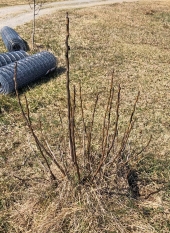
 1
1




 4
4




"The rule of no realm is mine. But all worthy things that are in peril as the world now stands, these are my care. And for my part, I shall not wholly fail in my task if anything that passes through this night can still grow fairer or bear fruit and flower again in days to come. For I too am a steward. Did you not know?" Gandolf

 2
2




List of Bryant RedHawk's Epic Soil Series Threads We love visitors, that's why we live in a secluded cabin deep in the woods. "Buzzard's Roost (Asnikiye Heca) Farm." Promoting permaculture to save our planet.
 1
1



















 1
1




List of Bryant RedHawk's Epic Soil Series Threads We love visitors, that's why we live in a secluded cabin deep in the woods. "Buzzard's Roost (Asnikiye Heca) Farm." Promoting permaculture to save our planet.
















 1
1




William Bronson wrote: Can we posit that it is the fungal network that makes that determination?
A living root system might cooperate with a new tree, a dead and decayed one might be food for a new tree.
Can the process of decay lock up nitrogen that that the new tree might other wise use?
If we wanted to accelerate the decay and keep the soil nitrogen available we could bore holes in the stump and pack them with urine/manure.
List of Bryant RedHawk's Epic Soil Series Threads We love visitors, that's why we live in a secluded cabin deep in the woods. "Buzzard's Roost (Asnikiye Heca) Farm." Promoting permaculture to save our planet.
 3
3




























William Bronson wrote:Bryant, I've mixed autumn leaves I with my raised beds, only to have poor results. I've read that was due to the available nitrogen being used by the soil organisms in the process of decaying the carbon in the leaves.
Top dressing with these leaves seems to avoid this.
This narrative y parallels the woodchip narrative, but you have me questioning both.
I had imagined that adding nitrogen rich urine etc, would feed the fungus and o the soil life, fueling decay.
The idea of nonmycorrhizal networking is also new to me.
I'll have to drop in on your soil building thread and refine my understanding.
List of Bryant RedHawk's Epic Soil Series Threads We love visitors, that's why we live in a secluded cabin deep in the woods. "Buzzard's Roost (Asnikiye Heca) Farm." Promoting permaculture to save our planet.
















Tim Kivi wrote:Well I planted my apple tree next to the big stump. I should take a picture for the future to show how it turns out.
List of Bryant RedHawk's Epic Soil Series Threads We love visitors, that's why we live in a secluded cabin deep in the woods. "Buzzard's Roost (Asnikiye Heca) Farm." Promoting permaculture to save our planet.

|
What consumes your mind controls your life / tiny ad
Rocket Mass Heater Resources Wiki
https://permies.com/w/rmh-resources
|



